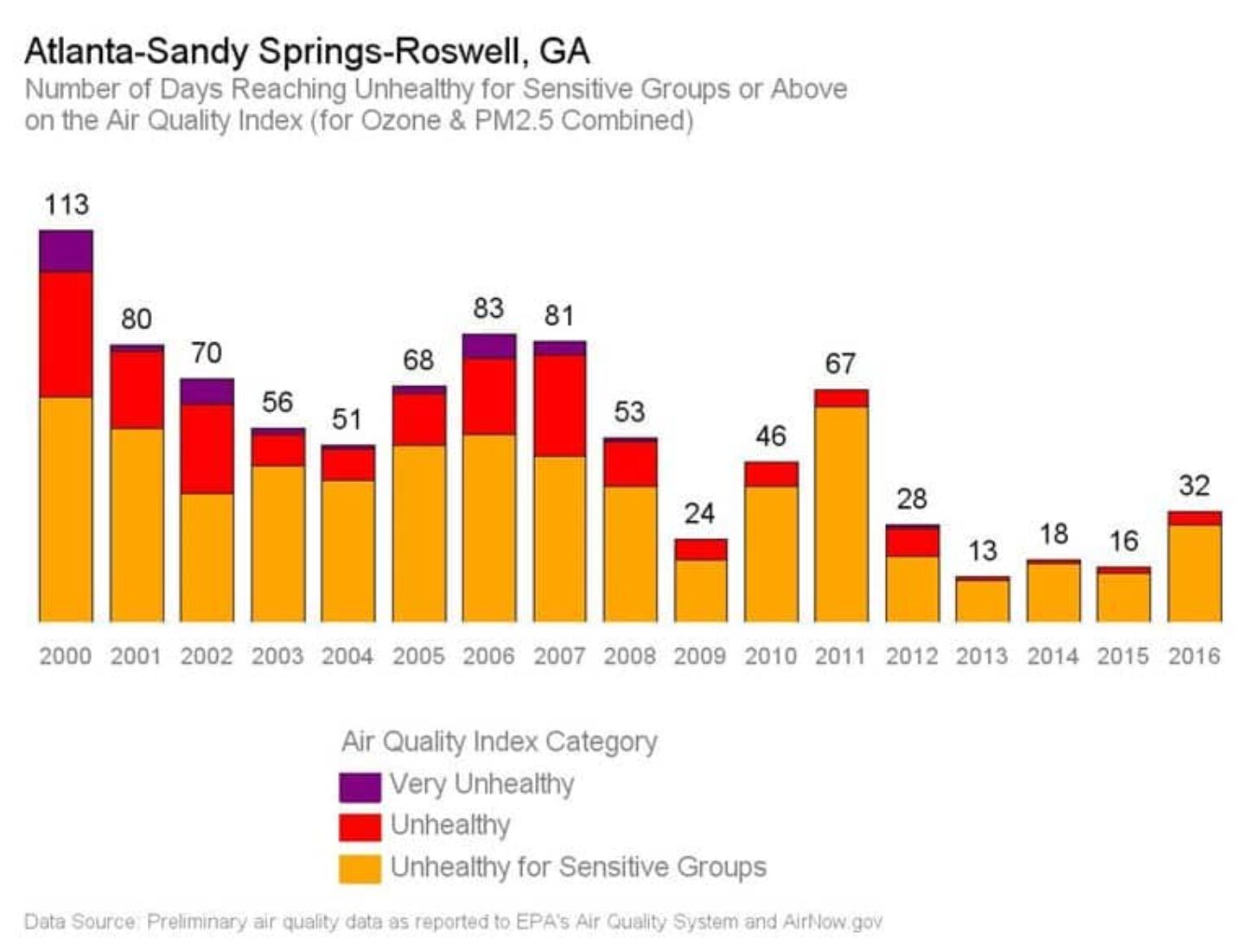
The American Lung Association emphasizes the bad news and mentions the good. Its State of the Air 2018 report (using 2014-2016 data) claims that “ozone pollution worsened significantly.”
It is clear, however, that the air in Georgia has become cleaner and healthier. Atlanta had an average of 66 days per year from 2000 to 2010 that were “unhealthy for sensitive groups,” but only 21 days per year from 2011-2016 (see chart).
The two pollutants most blamed for the “unhealthy” air have decreased. Ozone (4th maximum 8-hour concentration) decreased 27 percent from 2000 to 2017, while tiny particles (PM2.5) dropped by 50 percent.
Respiratory disease causes, changes in the Environmental Protection Agency’s regulations and environmental advocates’ claims have produced an absolute maze of the role of air pollution in respiratory disorders.

The EPA has, for 40 years, ordered increasingly stringent reductions in the amount of ozone and particles allowable in the air, in large part to reduce asthma, even though there is no evidence it has helped. The prevalence of lifetime asthma among children has hovered around 15 percent for decades.
From 1979 to 1997, the maximum allowable level for ozone was set at 120 parts per billion (ppb), averaged over one hour. During this period, maximum one-hour ozone concentrations for the nation decreased 20 percent. Meanwhile, the rate of doctor visits for asthma increased 25 percent.
Since 1997, the standard has been based on an 8-hour average and toughened, from 80 to 75, and then to 70 ppb. In Atlanta in 1999, just 24 days exceeded the 120 ppb standard; 68 days exceeded the new 80 ppb standard.
When the EPA first estimated the number of people at risk of breathing too much ozone in 1984, it counted those living in counties that exceeded the ozone limits. The first estimate was 79.2 million. By 1996, that had dropped 50 percent, to 39.3 million. And the ozone limit was toughened.
In 1997, with the new limit, the population in counties exceeding the standard rose 2.5 times to 101.6 million. A couple of years later the standard for particles in the air also was made more stringent. Since then, the numbers living in “Non-Attainment” areas for ozone and particles varied from about 125 to 175 million without much pattern.
Ozone levels in Atlanta are down 25 percent since 2000. But asthma sufferers’ ER visits are up 18 percent since 1992-1995. If ozone was reduced and serious asthma attacks increased, what will further ozone reductions do?
About the unexpected opposite trends of ozone and asthma, the EPA conveniently hedged its bets in a 2003 publication: “While on the surface, this appears to suggest that air pollution is not related to the incidence or prevalence of asthma, there are too many complexities and uncertainties to draw this conclusion.”
The “complexities and uncertainties” make the connection doubtful. The EPA website lists nine triggers for asthma. Secondhand smoke, dust mites, molds, cockroaches and pests, pets and chemical irritants are listed ahead of outdoor pollution.
In studies of the connection between ozone and asthma in large populations, which the EPA uses to justify setting tougher standards, it is not just ozone and particles triggering asthma. All of these other, more important triggers confound the connection.
There are still other confounding facts:
- All over the United States the prevalence of asthma is as high, and sometimes higher, in counties that don’t exceed EPA air quality standards, as in “non-attainment” counties.
- More asthma problems occur in months meeting the EPA air quality standards than in summer months recording non-attainment. In a Tennessee asthma report, ER visits for asthma from 2002-2006 were 62 percent higher in November-December than in June-August. A web page for Atlanta Allergy and Asthma, which claims to be the largest allergy practice in Georgia, explains the seasonality of asthma from their experience, “Asthmatics often enjoy a reprieve from symptoms during the summer months, but ER visits for asthma increase during September and October.”
Imagine that: a reprieve during the height of the ozone season! The air pollution-asthma riddle has no end of contradictions.
